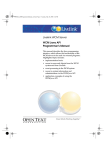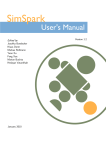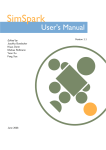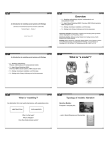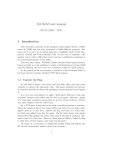Download PRACTIONIST User Guide - Practionist.org
Transcript
R&D Lab Palermo, Italy http://res.eng.it PRACTIONIST Framework User Guide © Engineering Ingegneria Informatica S.p.A., 2008 PRACTIONIST Framework – User Guide Version: 1.0 Table of contents 1 What is the PRACTIONIST framework? ....................................................................................................... 3 2 PRACTIONIST requirements ......................................................................................................................... 4 3 Installing PRACTIONIST ............................................................................................................................... 5 4 Developing PRACTIONIST multi-agent systems .......................................................................................... 5 5 Starting PRACTIONIST agents ...................................................................................................................... 5 6 5.1 Using the Ant tool..................................................................................................................................... 6 5.2 Using the Agent Starter GUI .................................................................................................................... 7 Debugging a PRACTIONIST agent: the PAIT tool ........................................................................................ 8 6.1 Plan Library .............................................................................................................................................. 9 6.2 Events ..................................................................................................................................................... 10 6.3 Desires/Intentions ................................................................................................................................... 11 6.4 Beliefs ..................................................................................................................................................... 11 6.5 Beliefs updates ........................................................................................................................................ 12 6.6 Intended means ....................................................................................................................................... 13 6.7 Messages................................................................................................................................................. 13 PRACTIcal reasONIng sySTem www.practionist.org Pag. - 2 - PRACTIONIST Framework – User Guide Version: 1.0 1 What is the PRACTIONIST framework? PRACTIONIST (PRACTIcal reasONIng sySTem), is a new framework built on the Bratman’s theory of practical reasoning to support the development of BDI agents in Java. The framework is built on top of JADE [11], a widespread platform that implements the FIPA specifications and that provides some core services, such as a communication infrastructure, agent life-cycle management, and so forth; therefore, in the PRACTIONIST framework, agents are deployed within JADE containers and have a belief base implemented in Prolog or in Java, as shown in the following figure: Figure 1-1 PRACTIONIST over JADE and Prolog. The framework adopts a goal-oriented approach to develop BDI agents and stresses the separation between the deliberation process and the means-ends reasoning, with the abstraction of goal used to formally define both desires and intentions during the deliberation phase; in other words, PRACTIONIST agents can be programmed in terms of goals. A PRACTIONIST agent is a software component endowed with the following elements (shown in Figure 1-2): • a set of perceptions and the corresponding perceptors that listen to some relevant external stimuli; • a set of beliefs representing the information the agent has got about both its internal state and the external environment; • a set of goals the agent wishes or wants to pursue. They represent some states of affairs to bring about or activities to perform and will be related to either its desires or intentions (see below); • a set of goal relations the agent uses during the deliberation process and means-ends reasoning; • a set of plans that are the means to achieve its intentions; • a set of actions the agent can perform to act over its environment; and • a set of effectors that actually execute the actions. As shown in Figure 1-2, PRACTIONIST agents are structured in two main layers: the framework defines the execution logic and provides the built-in components according to such logic, while the top layer includes the specific agent components to be implemented, in order to satisfy system requirements. PRACTIcal reasONIng sySTem www.practionist.org Pag. - 3 - PRACTIONIST Framework – User Guide Version: 1.0 Figure 1-2 Components of PRACTIONIST agents. Moreover, by using the Belief Logic, PRACTIONIST agents are able to reason about their beliefs and the other agent’s beliefs, since beliefs are not simple grounded literals or data structures but modal logic formulas. 2 PRACTIONIST requirements PRACTIONIST is a framework fully implemented in Java, so you need the Java Run Time Environment 1.4 or higher (http://java.sun.com/). Some others prerequisites of the PRACTIONIST framework are listed: • JADE (http://jade.tilab.com/), a widespread platform that implements the FIPA specifications and provides some core services, such as a communication infrastructure, agent life-cycle management, and so forth. We have built and tested our framework with JADE 3.3. • tuProlog (http://tuprolog.alice.unibo.it/), a Java-based Prolog which has been included in our framework with the version 1.3.0. • JPL (http://www.swi-prolog.org/), a Java Interface to Prolog included in the SWI-Prolog distribution. The SWI-Prolog installation is required if agents you use in your applications have a prolog belief base. We have built and tested our framework with JPL 3.0.3 (it is included in the SWI-Prolog 5.4.7 executable file). • log4j (http://logging.apache.org/), a logging framework included in the Apache Logging Services Project. We have tested our framework with log4j 1.2.8. • Xerces (http://xerces.apache.org/), a Java XML Parser developed by the Apache Software Foundation. If agents you develop will use the choreography support builded in our framework, then it is mandatory the installation of Xerces. We have tested our framework with Xerces 1.1. PRACTIcal reasONIng sySTem www.practionist.org Pag. - 4 - PRACTIONIST Framework – User Guide Version: 1.0 3 Installing PRACTIONIST To install PRACTIONIST, you need to have the PRACTIONIST distribution file; in the download section of the PRACTIONIST web site (http://www.practionist.org), you can find the zip archive containing the framework already compiled. You have to follow the steps below to install and use the PRACTIONIST framework in your projects: 1. download the zip file containing the PRACTIONIST jar archive; 2. download the JADE jar archives and the log4j jar archive; 3. download the jpl library (see the previous section for further details about the requirement of this library); 4. download the Xerces library (see the previous section for further details about the requirement of this library); 5. import the downloaded libraries into your project; Remember to set the path of the imported jar archives into the class path to execute correctly your applications. If you have already installed SWI-Prolog, you has to add the jpl.dll location to the PATH environment variable (e.g. %ProgramFiles%\pl\bin, if SWI-Prolog has been installed in the default directory). It's strongly recommended to install Apache Ant (http://ant.apache.org/), as every executable component in the framework has an Ant build file associated to it; moreover it's necessary to add the Ant's bin location to the PATH environment variable (e.g. %ProgramFiles%\apache-ant-X.Y.Z\bin, where X.Y.Z denotes the Ant version installed). 4 Developing PRACTIONIST multi-agent systems Once the PRACTIONIST framework is correctly installed, you can start developing your own software applications. The framework supports such a development phase by providing several useful libraries, including interfaces, abstract classes, default components, internal services implementing the computation model of PRACTIONIST agents, etc. How to program PRACTIONIST agents is described in details in the PRACTIONIST Programmer Guide. 5 Starting PRACTIONIST agents As stated in section 1, the PRACTIONIST framework is built on top of JADE. Therefore a running JADE platform represents a mandatory requirement to start a PRACTIONIST agent. We have defined a PRACTIONIST agent starter, which is a JADE agent with the purpose of starting a PRACTIONIST agent, initializing its main behaviour. This agent is represented by the Java class AgentStarter included in org.practionist.core and requires some arguments to start a PRACTIONIST agent: the package • the agent class, as the first parameter, which is a string representing the class name, including its package declaration (e.g. myapp.agent.MyAgent). This argument is mandatory: if it is missing then the agent initialization phase fails; • true if you want to start the PRACTIONIST Agent Introspection Tool (PAIT), false otherwise; • others arguments to pass to the agent in a string format, if there are. You have different options to start your PRACTIONIST agent: • you can define a “build.xml” file with the proper targets and use the Apache Ant tool to execute these; PRACTIcal reasONIng sySTem www.practionist.org Pag. - 5 - PRACTIONIST Framework – User Guide Version: 1.0 • you can use the PRACTIONIST Agent Starter GUI, by which you can set some parameters, such as the agent class, the agent name, etc., and finally • you can use a batch file. The following subsections describe how to start a PRACTIONIST agent by using each of the above methods. 5.1 Using the Ant tool If you want start your agents by using the Apache Ant tool, then you have to create a build file with some targets, each one associated to an executable agent. In the following figure, the build file required to execute the “example agent” is shown: Figure 5-1 An example of Ant build file. You should focus your attention in the definition of the agent.name property: its value contains the name of the agent (e.g. pippo), the agent starter (org.practionist.core.AgentStarter), the PRACTIONIST agent class (examples.ExampleAgent) and its argument, that are the string “true“ (to enable the PAIT tool) and the path of the file containing the initial belief base. PRACTIcal reasONIng sySTem www.practionist.org Pag. - 6 - PRACTIONIST Framework – User Guide Version: 1.0 5.2 Using the Agent Starter GUI The class AgentStarter in the package org.practionist.core represents the GUI shown in Figure 5-2, which you can use to set or to load some properties required to start your agents. In the upper part of the GUI, you can set the parameters regarding the JADE platform and container into which the agent has to be executed: • The RMI Registry, that is an integer representing the port number where the Main Container is listening to container registrations; the default value is 1099. At the moment, the Main Container must be localized on a local JADE platform. • The default PRACTIONIST container: if you select this check box, your agent will be created into a container called “PRACTIONIST”, otherwise a new container will be created. Into the default container, only one agent with a prolog belief base at a time can be created (see the programmer’s guide for more details). Instead, in the lower part of the GUI, you have to set the parameters regarding the agent to execute: • The nickname of the agent. • The class identifying the agent. • The file containing the initial belief base of the agent, if any. • Some arguments the agent requires, if any. • The PAIT tool, if you select this check box, the GUI of the PAIT tool regarding the agent will be created after the agent creation. Figure 5-2 PRACTIONIST Agent Starter GUI. You can also set all these properties into a configuration file with the “.properties” extension, and load it by clicking on the “Load properties” button. An example of it is shown in the following figure: PRACTIcal reasONIng sySTem www.practionist.org Pag. - 7 - PRACTIONIST Framework – User Guide Version: 1.0 Figure 5-3 An example of configuration file. Finally, you have to click on the “StartUp” button to start the agent. 6 Debugging a PRACTIONIST agent: the PAIT tool The framework provides developers with the PRACTIONIST Agent Introspection Tool (PAIT), a visual integrated monitoring and debugging tool, which supports the analysis of the agent’s state during its execution. In particular, the PAIT can be suitable to display, test and debug the agents’ relevant entities and execution flow. Each of these components can be observed at run-time through a set of specific tabs (see Figure 6-1); the content of each tab can be also displayed in an independent window. PRACTIcal reasONIng sySTem www.practionist.org Pag. - 8 - PRACTIONIST Framework – User Guide Version: 1.0 Figure 6-1 The PRACTIONIST Agent Introspection Tool (PAIT). In the following subsections, the views provided by PAIT are presented. 6.1 Plan Library This view shows the list of plans within the plan library of the considered agent (Figure 6-2). Some of these plans may have an associated plan description, that can be displayed as in Figure 6-3. PRACTIcal reasONIng sySTem www.practionist.org Pag. - 9 - PRACTIONIST Framework – User Guide Version: 1.0 Figure 6-2 Plan Library view. Figure 6-3 Plan description. 6.2 Events This view shows the list of events (i.e. desired goals, perceptions, changes in its beliefs) that the considered agent can handle (Figure 6-4). PRACTIcal reasONIng sySTem www.practionist.org Pag. - 10 - PRACTIONIST Framework – User Guide Version: 1.0 Figure 6-4 Events view. 6.3 Desires/Intentions This view shows the list of current desires and intentions of the considered agent (Figure 6-5). Figure 6-5 Desires/Intentions view. 6.4 Beliefs This view shows the whole belief base of the considered agent, providing the opportunity to browse it by using the tree structure on the left. PRACTIcal reasONIng sySTem www.practionist.org Pag. - 11 - PRACTIONIST Framework – User Guide Version: 1.0 Figure 6-6 Beliefs view. 6.5 Beliefs updates This view shows the list of beliefs updates within the considered agent (Figure 6-7). Figure 6-7 Belief updates view. PRACTIcal reasONIng sySTem www.practionist.org Pag. - 12 - PRACTIONIST Framework – User Guide Version: 1.0 6.6 Intended means This view shows the structure of intended means of the considered agent (Figure 6-8). On the left panel, the nested structure of the intended means is reported, while the main panel includes the traced messages within the selected intended means and its upper intended means. Figure 6-8 Intended means view. 6.7 Messages This view shows the list of messages sent and received by the considered agent (Figure 6-9). PRACTIcal reasONIng sySTem www.practionist.org Pag. - 13 - PRACTIONIST Framework – User Guide Version: 1.0 Figure 6-9 Messages view. PRACTIcal reasONIng sySTem www.practionist.org Pag. - 14 -
















